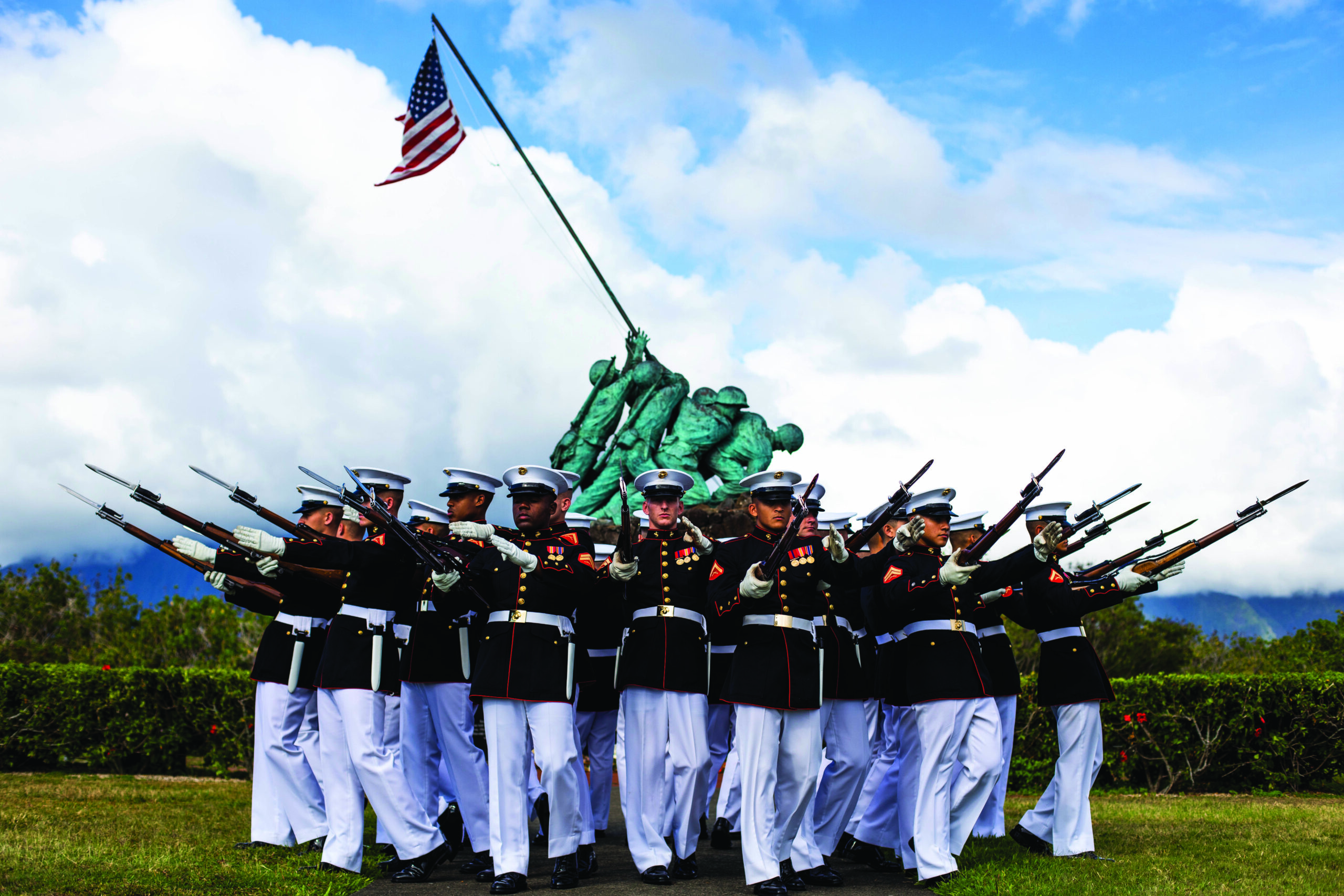
Remember What You Represent: The Marine Corps Silent Drill Platoon
By: Kyle WattsPosted on June 15, 2024
A highly selective and unique niche fills the ranks of the Marine Corps’ Silent Drill Platoon. Throughout the unit’s history, the platoon has proven unparalleled among the services at their craft and represented the Marine Corps on the grandest scale. To earn a spot with this elite group, a young Marine must begin proving himself from the moment he steps on the yellow footprints.
When a new infantry Marine graduates from Infantry Training Battalion, a select few receive assignment to Marine Barracks Washington, D.C. Selections are based on multiple characteristics, but character and performance trump all. Once finished with Ceremonial Drill School, the basic training for all new marching Marines at “8th and I,” fewer still receive the opportunity to compete for a spot with the Silent Drill Platoon.
Silent Drill School commences every December. Prospective candidates volunteer to showcase their skills and attention to detail. Some years, more than half of the platoon’s requirement of 39 Marines is vacated when some move into the fleet or civilian life. As the candidate pool is whittled down, instructors finalize the list of selectees. The platoon veterans then pack up and take off with the new selects for their culminating annual training event at Marine Corps Air Station Yuma, Ariz.
Spring training in Yuma lasts one month. The Marines work 12 or more hours a day, seven days a week, memorizing every muscle movement in the routine.
“In Yuma we learn the new sequence for the year and work to get the new guys in the platoon up to par,” said Corporal Alexander A. Rojas, 2nd Squad Leader in the platoon. “Training days are very long, every day.”
“It’s a grind, waking up at 0600 every morning and working until 10 o’clock at night,” added Cpl Jack N. Conner, 3rd Squad Leader. “But it’s a great way to get away from everything here at the barracks and just focus on ourselves, perfecting everything and preparing for the parade season.”
The platoon’s Drill Master, a senior corporal in his third or fourth year with the unit, creates the routine. He envisions the flow and tempo of each Marine and invents the paths they take, orchestrating their movements into a single, purposeful design. The platoon Rifle Inspector serves as the subject matter expert in rifle manual and spins. He and the Assistant Rifle Inspector take the lead in polishing the reflexes and hand-eye-coordination of each Marine to ensure a flawless performance.
While the Drill Master and Rifle Inspector work together to create a unique performance, flavored with their personal brand of experience and style, several major portions of the routine endure as Silent Drill Platoon traditions. Anyone familiar with the platoon recognizes the iconic “bursting bomb” formation, or “long line” rifle inspection sequence. Like all Marines, Silent Drill Platoon members idolize their forerunners, embrace their unit history, and pass their creed onto a new generation each year.
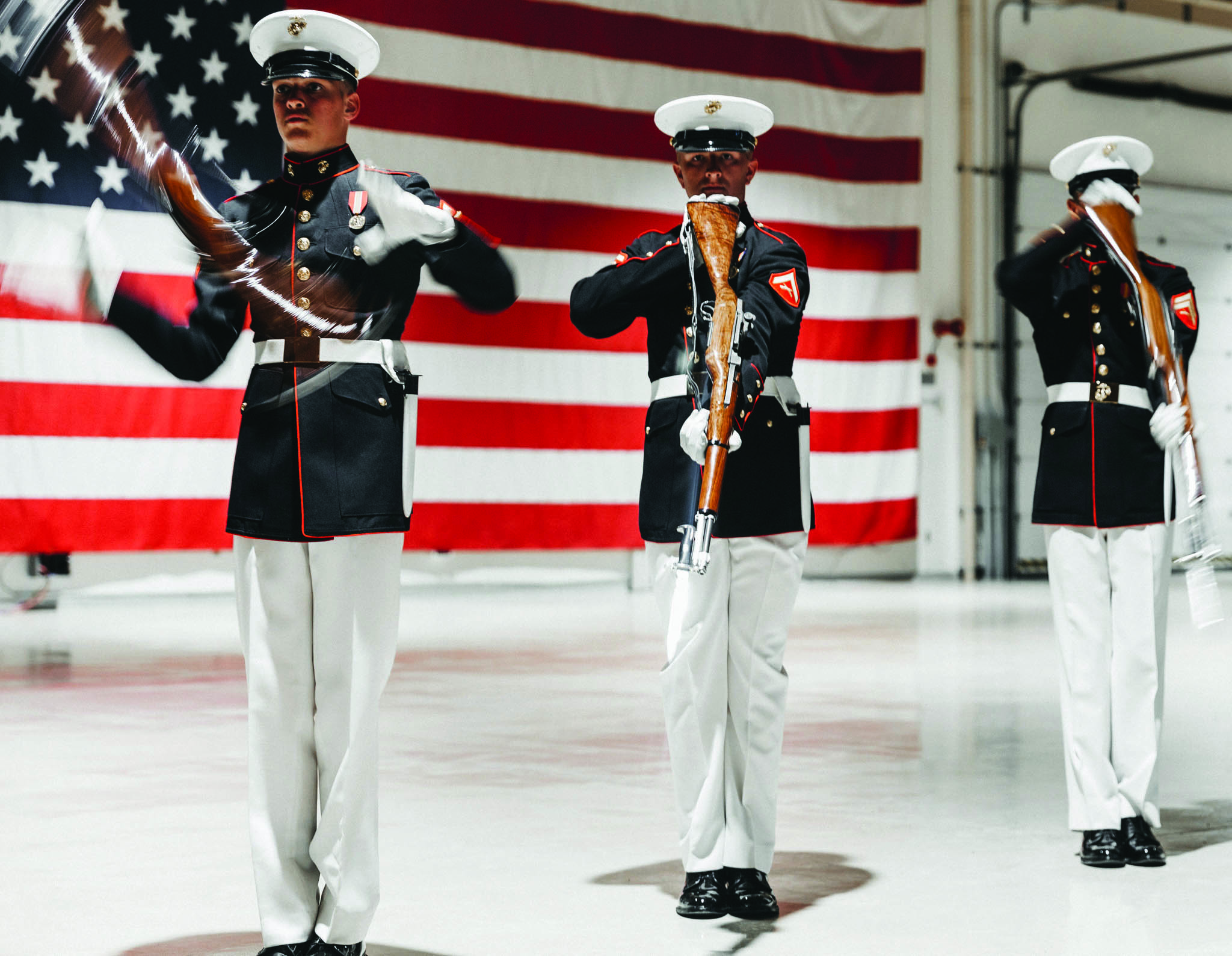
The legacy of the Silent Drill Platoon originated in 1948. Though intended as a one-time performance, the first version of the team received an overwhelming and enthusiastic response. The public demanded repeat performances. As a result, the platoon eventually became a permanent part of Marine Barracks Washington. Throughout its history, newly minted infantrymen, prior to their first tour in the fleet, filled out the platoon. The Marines today celebrate one notable exception to this standard, memorializing a unique point in time on their barracks wall. A black and white photograph displayed in the passageway depicts the platoon during the Vietnam War, when even the Marines of the Silent Drill Platoon deployed to combat. The photo looks much like any other taken of the platoon in formation, except that each Marine wears sergeant or staff sergeant chevrons and a chest full of medals.
The Marines proudly differentiate themselves through numerous traditions passed down over the years. From tattoos to unique uniform details, some traditions are held sacred and recognized only by veterans of the platoon. The coveted silver buttons worn by the number one Rifle Inspector represent one of the more widely known rituals. Since the 1970s, the Rifle Inspector has removed the brass buttons from his dress blues and entrusted them to his successor. Over time and through constant polishing, the buttons turned silver and became a trademark feature. The original buttons are preserved today in a glass case, still handed down to each new Rifle Inspector for safe keeping, while he sews another set of silver buttons to his blouse to keep the tradition alive. As a far lesser known or visible tradition, when practicing drill out of uniform, the Marines adopt the style of their predecessors, drilling in Converse hightop shoes. A keen observer might notice the iconic shoes tied differently from Marine to Marine, laced one eyelet farther down to signify the number of years a Marine has served with the platoon.
The summer parade season is the platoon’s primary tradition and premier event, and is the most widely anticipated engagement every year. Most spectators familiar with the Silent Drill Platoon recognize the unit from one of their classic performances at a Friday Evening Parade or Tuesday Sunset Parade. Running June through August, these two performances every week represent the minimum of the platoon’s time commitment. The Marines travel all over the country, and sometimes internationally, performing at a variety of venues. One day, the platoon might execute their routine in a local high school gymnasium for a group of students and their parents. The next night, the Marines could be standing on the 50-yard line during the halftime show of a National Football League game in front of thousands of cheering fans. Often, the Marines land back in Washington, D.C., within an hour or two of their next performance at an Evening Parade. They don their dress blues, proceed directly onto the parade field, then fly out once again the following morning for their next performance.
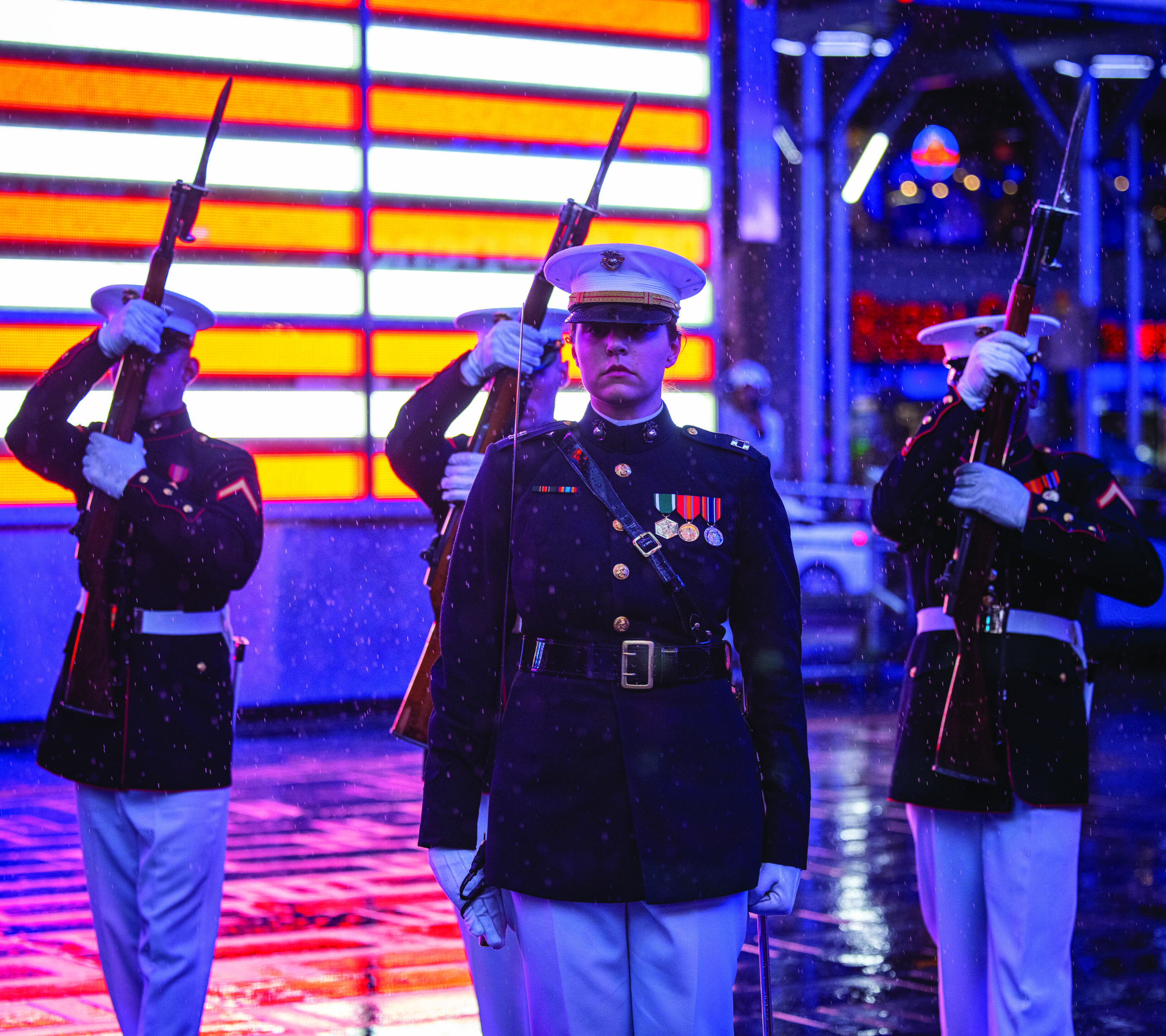
In addition to performing, traveling, and remaining the best in the business at slide drill and rifle spinning, platoon members must maintain proficiency in the basic skills as an infantry Marine.
“It’s a tight window, but we throw in infantry classes, land nav classes, and practical application on our annex field here in D.C. whenever we can,” Corporal Christopher I. Houck stated, who serves as 1st Squad Leader. “Sometimes it’s tough to get in training here in the city, but we use whatever resources we can.”
Houck and the other squad leaders prepare the Professional Military Education to be covered during their days abroad. Several times a year, the platoon travels to Marine Corps Base Quantico, Va., to practice infantry tactics in the field and complete their basic set of requirements. They spend time on the range for rifle qualification and complete their annual Physical Fitness and Combat Fitness Tests.
While extremely demanding and challenging, Silent Drill Platoon Marines take immense pride in their role. Not only because of the unique opportunity they possess to be one of the very few who have ever earned a spot with the platoon, but also because of what the unit represents about the Corps and our beloved history. When the elevator door opens onto the Silent Drill Platoon’s deck at 8th and I, a large wooden sign is immediately visible to anyone visiting, and to Marines returning home. “Remember what you represent.” There’s nothing ambiguous about the meaning behind those words for the Marines of the Silent Drill Platoon—they are part of something greater than themselves.
Plaques, memorials, and photographs evenly spaced down each passageway contrast against the black-painted walls in distinguished prominence. Each tells a proud story of platoon history, remembers an extraordinary example of bearing and fortitude, or recognizes individual Marines for their performance.
One stunning memorial just beyond the elevator door remembers Lance Corporal Davis M. Mosqueda. While on holiday leave in his hometown of Boise, Idaho, Mosqueda joined a party on Dec. 30, 2020. When gunshots rang out from the apartment parking lot, Mosqueda realized one of his friends was outside and in danger. He ignored the threat and moved outside in order to protect his friend. In the process, the assailant shot and killed Mosqueda. To recognize his off-duty example of honor, courage, and commitment, a pencil sketch of Mosqueda performing with the platoon stands alongside his M1 Garand bayonet and several other items in his memory.
Other memorials along the wall pay tribute to Marines who displayed exemplary demeanor during a performance as a reminder that no matter what occurs, you must maintain your bearing. On April 28, 2004, LCpl Jamar C. Bailey executed his part on the rifle inspection team during a performance at 8th and I. According to his Certificate of Commendation, “At the moment when two rifles are exchanged between three Marines, the rifle that was thrown to Lance Corporal Bailey was not in the proper position … and struck him in the face. The front sight post caught him in the cheek and opened a 2-inch long cut.”
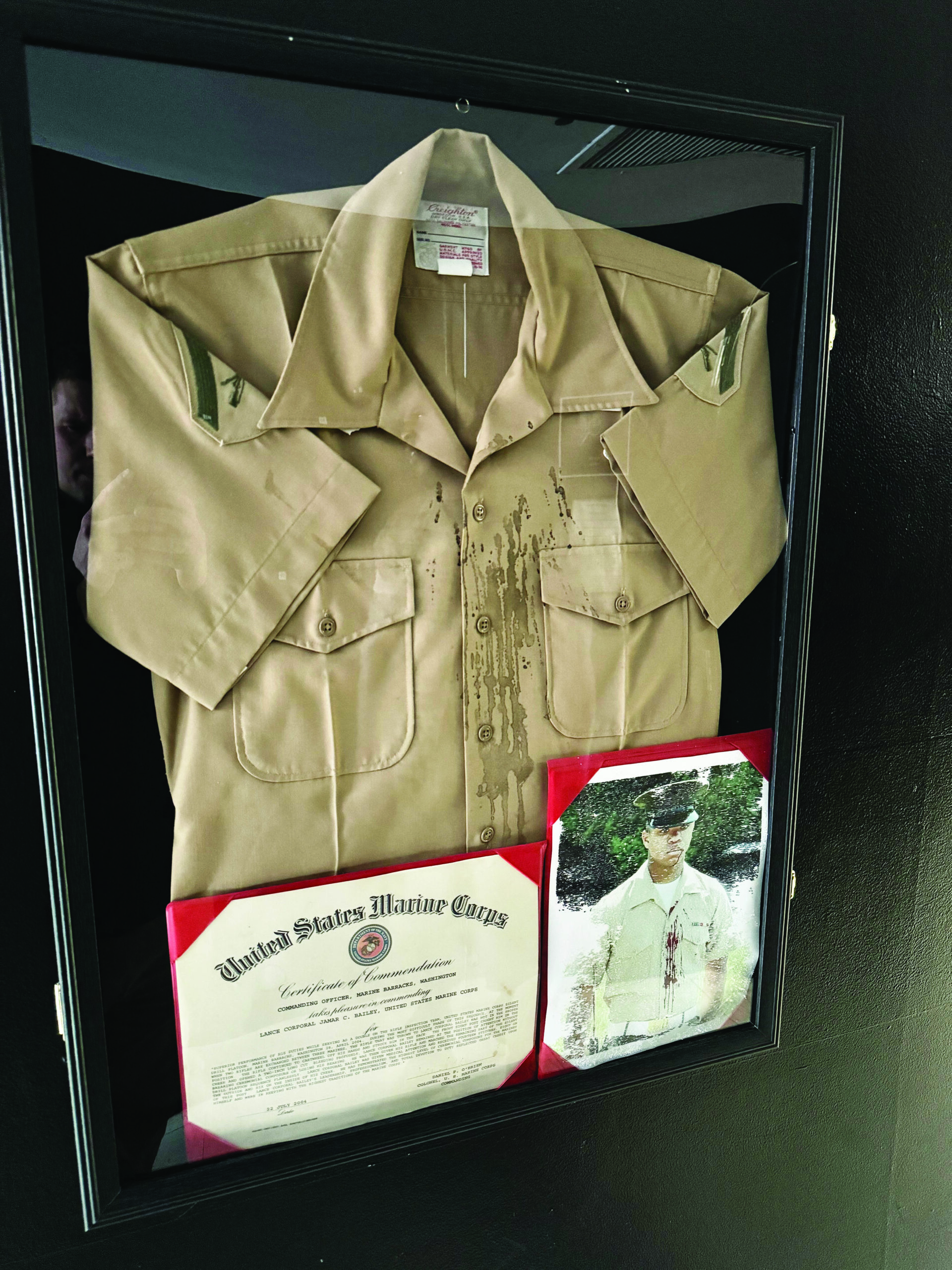
A photograph next to Bailey’s certificate shows him standing at attention as he continued on to flawlessly finish out the remainder of the performance. Blood pours down his chin and covers his blouse. It took 14 stitches to sew his face back together. His bloodstained blouse hangs in the display case with his photo as a testament to his outstanding example of commitment to his profession.
Another plaque on display serves as a persistent reminder to all Marines in the platoon that their role is constantly under evaluation and up for grabs. Dedicated by the outgoing platoon leadership in 2022, the “Old Dogs and New Dogs” plaque recognizes both the top performing platoon veteran and rookie each year.
The Marines named here earn their spot in the marching 24. The remaining 22 spots are highly coveted and must be earned throughout the year. Character and discipline play a primary function in securing a role in the platoon. To achieve the highest honor of marching with the 24, each Marine must be constantly ready for Challenge Day.
The first Challenge Day of the year comes at the end of spring training when the initial marching 24 are finalized. Every Marines understands, however, that his spot in the 24 remains secure only through demonstrating the highest level of proficiency and character. The number of Challenge Days in a year varies at the discretion of the platoon leadership. They come as a surprise, unannounced until the morning of, forcing each Marine to remain constantly prepared. Every Marine in the platoon performs the routine from start to finish, individually and under close scrutiny of the Drill Master. They receive a composite score at the end, and the highest scores fill out the marching 24. The intense level of preparation required for competition against their peers enables those who achieve the marching 24 to perform under any circumstances, in front of any audience.
Silent Drill Platoon Marines consider their bearing as a leadership trait held in the highest regard. They revere examples such as Jamar Bailey and others who, under extraordinary circumstances, maintained their bearing, performed their drill routine, and demonstrated exactly the type of character the Marine Corps wants to embody. On rare occasions, mistakes are made. Hats cock to the side and fall off, or rifles are dropped. In cases such as this, the Marines remain stoic on the outside while the Rifle Inspector corrects the problem as he moves down the line.
Performing on the grandest stage, at the highest level of visibility, appears not to unnerve the Marines. Representing the heart and soul of what the public envisions about the Marine Corps drives the platoon to perform flawlessly, regardless of the circumstances surrounding the occasion. In March 2023, the Silent Drill Platoon travelled to Anchorage, Alaska, to perform at the opening ceremony of the 51st annual Iditarod sled dog race. Before dawn, with temperatures hovering below zero, the platoon donned hoodies and beanies to practice their routine a final time in the quiet, empty street near the starting line. Several hours later, they marched out once more in full uniform before the cheering crowd. The Marines executed the drill on a slippery and snow-covered street, while the temperature rose barely above zero. Their incredible discipline and professionalism marked an awesome first-time appearance for the platoon at the event.
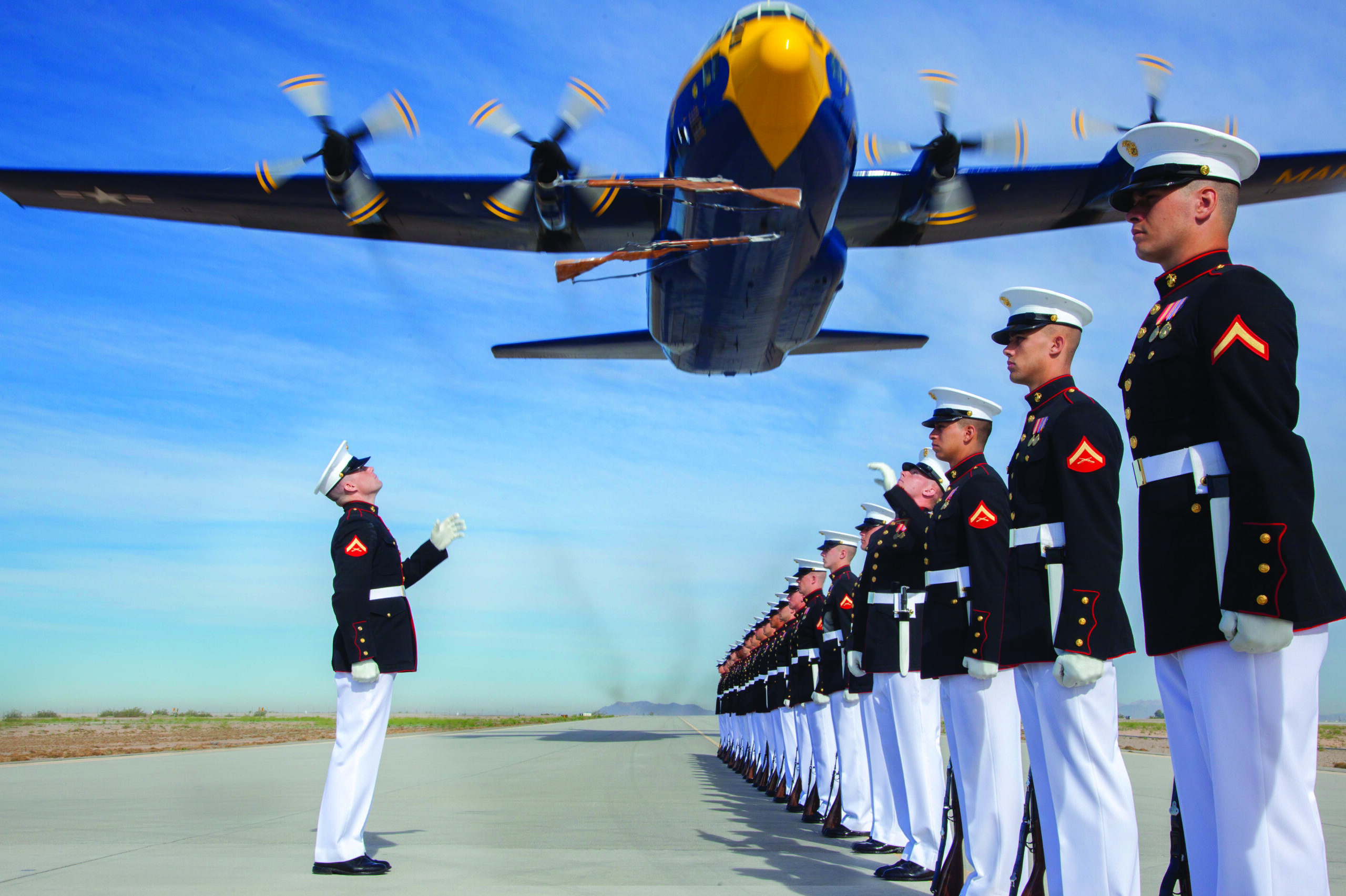
Fleet Week in New York City arrived two months later. In front of an audience of civilians, allied nation military representatives, and members of each branch of the U.S. Armed Forces, the Silent Drill Platoon shone. They performed their solemn and respectful routine in the center of Times Square with fluorescent flashing lights all around, traffic and car horns blaring, police whistles signaling, and people shouting. A nearly torrential downpour elevated the impact of the performance, as the Marines flowed together unfazed by the rain, spinning, flipping, and tossing their soaked rifles with soaked gloves.
One annual opportunity offers the Marines a chance to prove they truly are the masters of their craft. Drill teams from each branch of service compete head-to-head at the Joint Service Drill Exhibition every spring near the National Mall in Washington, D.C. On April 15, the Silent Drill Platoon wowed the crowd once again, outperforming teams from the Navy, Coast Guard, Army, and Air Force to win the competition for the third year in a row.
The character traits Marines perfect during their time with the Silent Drill Platoon serve them well over the rest of their career.
“None of us have been to the fleet yet, but a lot of friends who have gone on from here have become very successful,” said Cpl Conner. “They have a lot of unique skills; the attention to detail, the discipline, ability to teach, ability to learn quickly; and take them with them. We’ve had guys go to MARSOC, we’ve had guys go to Recon. Others lateral move and find success in a different MOS.”
“The intangibles these Marines take with them from being part of the platoon sets them up for success,” said Captain Gregory Jones, the Silent Drill Platoon Commander. “It pays dividends wherever they decide to go from here.”
Regardless of their next duty station, a Marine’s time with the Silent Drill Platoon remains a cherished time in their career. The pride they take reflects what other Marine veterans feel when we watch them perform. Throughout our lives, the title of “Marine” endures as the proudest we have earned. With each performance, the Silent Drill Platoon offers outsiders a glimpse of why.
Author’s bio: Kyle Watts is the staff writer for Leatherneck. He served on active duty in the Marine Corps as a communications officer from 2009-2013. He is the 2019 winner of the Colonel Robert Debs Heinl Jr. Award for Marine Corps History. He lives in Richmond, Va., with his wife and three children.




